Not buying it: 5 tips for buying less stuff
The world doesn’t have a recycling crisis, it has an overconsumption crisis. These words (by my friend Oberon, author of the book The Family Guide to Waste-Free Living) ring true to my ears. Sure, we need returnable packaging and reusable products and fixable items, single-use items that compost, products that are designed to last, and circular models that keep items in use.
But even this is not enough, at our current rate of consumption.
We* need to be buying (and using) less stuff.
(I say *we as a society and a global community, recognising that within this there are plenty of people for whom this does not apply: those that do not have the resources to buy what they need, let alone more than they need; and those who already conserve all the resources they can, as two examples.)
Buying less stuff sounds easier than it is, for many of us. It’s so easy to buy stuff, and there is so much (beautiful, clever, thoughtful) stuff out there to buy.
And we know about it because our screens show us all of this fantastic stuff, in the way of social media feeds, adverts and articles. We receive emails. We see it in stores, we see it in catalogues or flyers.
We don’t even need to have the money to be able to buy the stuff we see. Credit is freely available. Buy now, pay later.
In a world that makes it so easy for us to buy stuff, and makes stuff that is so desirable, it is hard to say no.
But if we want to live in a more equitable and sustainable world, we have to learn to say “no” more. A lot more.
It’s not the cool opinion, of course. The more attractive (and marketable!) option is to persuade us to buy a bunch of shiny ‘sustainable’ stuff and encourage us to feel good about our choices.
But we can’t consume our way out of the issues we’re facing as a society and as a planet.
So in the face of all this advertising and all these beautiful things, how do we buy less stuff?
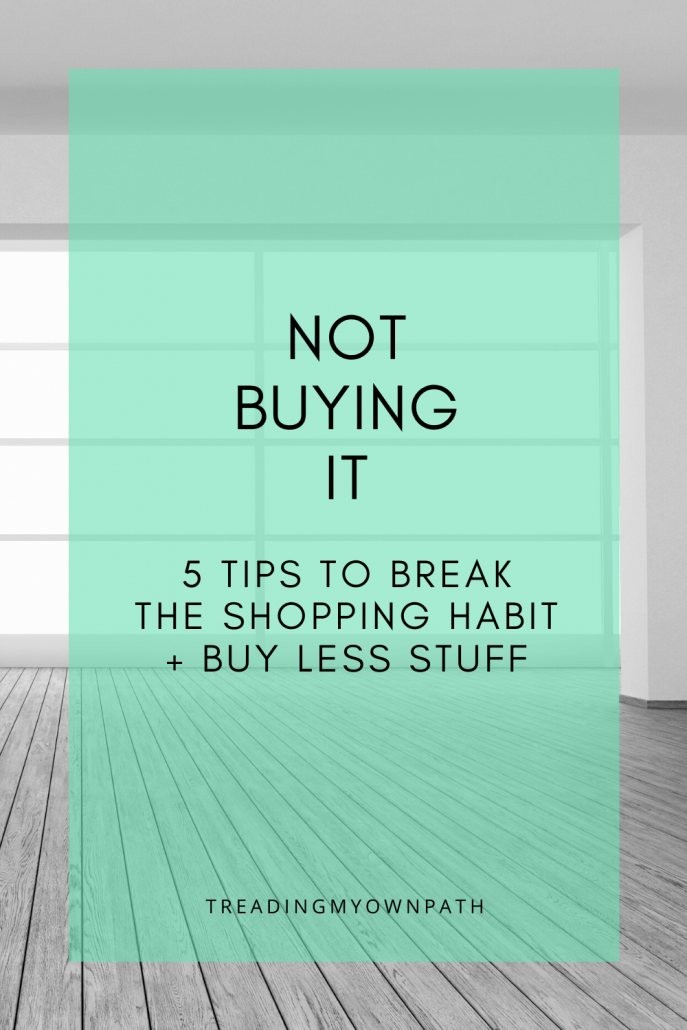
Stem the flow of advertising
What we don’t know about, we can’t buy. The less adverts we see, the less we’ll be tempted to buy things.
- Unsubscribe from all store newsletters. Everything is on sale of the time, products are constantly being upgraded and when you’re truly in need of something, you can go to them, rather than letting them come to you.
- If unsubscribing from everything feels like too much, choose the companies you spend the most money with, or the companies you tend to buy stuff from that you don’t actually use. Or even just the ones you don’t buy from anyway. Every single unsubscribe means less adverts, and less adverts mean less temptation.
- Install an adblocker on your laptop, desktop, tablet and mobile. I use Adblock Plus on my laptop and Adblock Browser on my phone. (Both are free.) They stop all those in-feed ads appearing in articles, and side bar ads appearing on computer screens.
- When looking at online stores, use a private browser. That way you won’t be tracked. The store won’t ‘remember’ what you were looking at, and you’ll get less sponsored ads in your social media feed showing you exactly the thing you were looking at two minutes ago, trying to wear you down.
- Put a ‘no advertising material accepted’ sticker on your mailbox, to avoid receiving catalogues. Get in the habit of putting unaddressed items straight in the recycling bin rather than bringing them inside. Anything that gets mailed to you can be returned unopened – cross through the address and write “not at this address, return to sender and remove from mailing list” on the packaging, and pop in the post box.
- Unfollow pages, businesses and people on social media that spend most of their time selling to you.
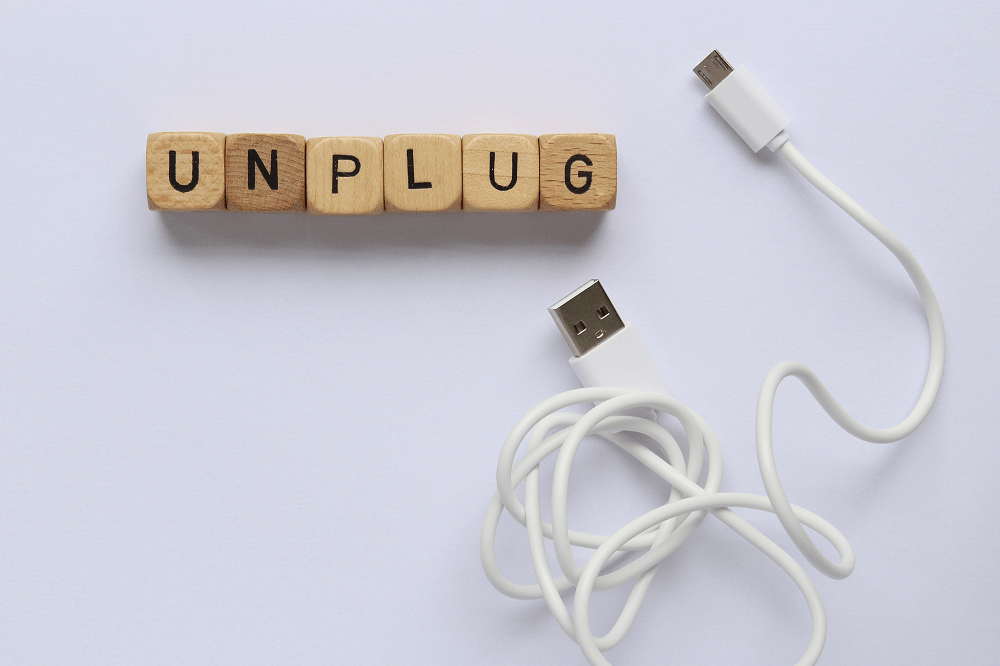
Mindset matters
Honestly, mindset must be the hardest part. It’s very easy to talk ourselves into the idea of buying stuff, whether convincing ourselves that we “need it”, making the case that it’s a ‘reward’ for a difficult week, or just sheer stubbornness: “why shouldn’t I buy it?”
Needs versus wants
Distinguishing between ‘needs’ and ‘wants’ can be challenging, particularly when the stuff is inherently useful. But useful is not the same as necessary.
One of the most useful questions to ask, is “did I go looking for this particular item to solve a problem I have, or did this product come to me offering to solve a problem I didn’t even know I had until I saw the product?“
Example 1, looking to solve a problem.
“My coffee plunger leaks when I pour it, and drips coffee all over the kitchen bench and my shoes and drives me crazy every morning. I’m going to look for a leakproof, drip proof version that doesn’t make me want to scream at breakfast.”
(Of course, problems are subjective and what’s a dealbreaker for someone is simply a mild annoyance to another. That’s not our place to judge. My coffee plungers drips everywhere and it infuriates me every single time I make a mess, but not enough for me to actually replace it. That doesn’t mean everyone would put up with it.)
Example 2, when the ‘solution’ comes to you.
“That kitchen draining organiser rack in this sponsored ad is so clever! It keeps everything so neat and tidy. My own dish draining rack is usually quite chaotic, come to think of it…”
I saw an ad just like this, and the product was clever. But ultimately it’s more stuff cluttering up my place, and another thing to store. Plus the main reason my dishes create so much clutter is because of the volume. (Reusables = dishes.) A dish rack isn’t really going to solve the problem.
We’re much more likely to make better decisions when we actively try to solve a problem, rather than passively letting adverts solve problems for us, which blurs the line between ‘need’ and ‘want’.
Stew on your choices
A useful way to distinguish between needs versus wants is simply to wait, before making a purchase.
How long (and whether) you wait depends on what it is and how much you need it, but assuming it’s a non-emergency purchase, 30 days can be a good length of time.
Did waiting increase your resolve to buy it, and reassure you that this is definitely something that you want to buy, did you realise you could make do with something else, or did you actually just forget about it altogether?
And if you feel like you can’t stew on this choice, because it’s a limited time offer, a sale item, there’s only one left, etc etc, remember that this scarcity marketing is a deliberate tactic that companies use to make us buy stuff.
What would it actually mean and what impact would it have on your life if you waited and the product was no longer available?
Only you can answer that, but it’s definitely a question worth asking.
Find a new reward that isn’t stuff
If you’ve ever gone shopping to cheer yourself up, or bought yourself stuff as a reward for a difficult week, finding a different reward that doesn’t require shopping can be helpful. This isn’t about deprivation or going without so much as filling the gaps with something else.
As a starting point, switching from buying ‘stuff’ to buying consumables (artisan soap or fancy chocolate, for example) can help. We’re not breaking the habit just yet, but we’re shifting it to something that doesn’t involve the accumulation of stuff.
An alternative could be to use your need for a shopping “fix” to buy some pantry grocery items, and donate them to a local food bank.

But the best way to avoid stuff is to find other ways to make ourselves feel better that do not require shopping, or going to the shops.
Taking a walk, listening to a podcast, taking a long bath, going for a run, swimming, picking up litter, reading a library book, playing an instrument, baking, learning a new skill, or something else that brings joy and peace and a sense of satisfaction.
Challenge your ‘not buying it’ muscle
Habits get stronger the more we do them. If we’re used to buying stuff, it’s going to be hard to change gear. But the more we don’t buy stuff, the better we get at it.
One way to reinforce the ‘not buying it’ habit, especially at the start, is to take a challenge. You want to pick something achievable – not buying anything ever again is probably a bit extreme. You could try buying nothing, or simply focus on no new clothes, or start by working on buying nothing new (so second-hand items are allowed).
Or you could challenge your idea of ‘enough’ – for example by deciding to only wear 3 outfits for a month, or only cooking meals that require one pan.
- Choose a challenge and set your rules, including any exceptions you want to include.
- Choose a timeframe: do you want to try for a month? Longer?
- Choose a reward for the end of the challenge that isn’t ‘stuff’ and ideally doesn’t involve spending. This helps rewiring your brain that buying stuff = reward. (You don’t need to only reward yourself if you’re ‘successful’ either – reward yourself for giving it a go.)
- Did you want to challenge a friend to join you? It can make it more fun if there’s someone else to share the pain with, and there’s nothing like some friendly competition to keep on track.
- Set aside some time at the end of the challenge to reflect. What worked well? What was hard? How did we feel? Were there any obvious stumbling blocks? What would we do differently next time?
If you struggle, cave in or make mistakes, pay attention to them. They are telling you how to do better next time. If your weakness is Fridays after work, fill that timeslot with another activity to stop you shopping. If you notice that social media encourages you to buy stuff, think about how you can change your usage to reduce this.
Accept that change isn’t easy, but it’s worth it.
Change isn’t easy, nor is it a straight line. But buying less stuff doesn’t have to feel like going without. It’s simply shifting priorities. Making room for stuff that isn’t ‘stuff’.
Buying less stuff means less strain on resources (both the earth’s natural resources, and your personal bank account).
Buying less stuff means you can reduce your debt, or start saving for stuff that really matters.
It frees up the time you spent online browsing, and at stores, to do more enjoyable and meaningful things.
Less stuff more us means more stuff for others. It’s more equitable.
It keeps your house less cluttered. There’s less to sort, and less to tidy. And less to declutter when you realise all that stuff you bought isn’t being used.
When you buy less, you can buy better. The reason I can afford to buy ethical and sustainable items, when I actually need them, is because I buy less overall. Buy less, choose well, make it last.
Now I’d love to hear from you! Do you struggle with resisting the urge to shop? Is there anything in particular you have a weakness for? Are you a master of not buying stuff? What are your secrets? How has your relationship with shopping and stuff changed over time? Anything else you’d like to add? Please share your thoughts in the comments below!
[leadpages_leadbox leadbox_id=1429a0746639c5] [/leadpages_leadbox]
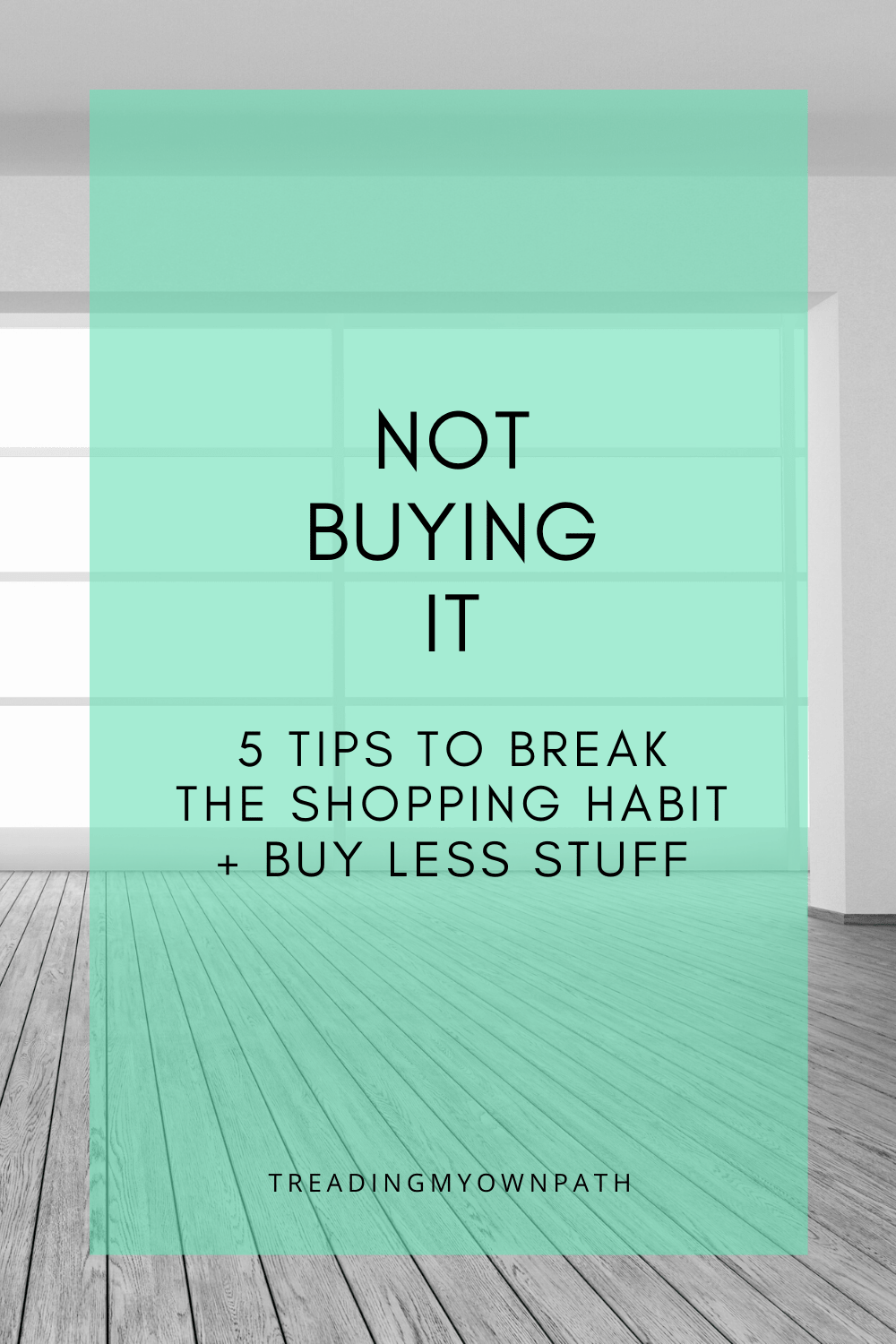
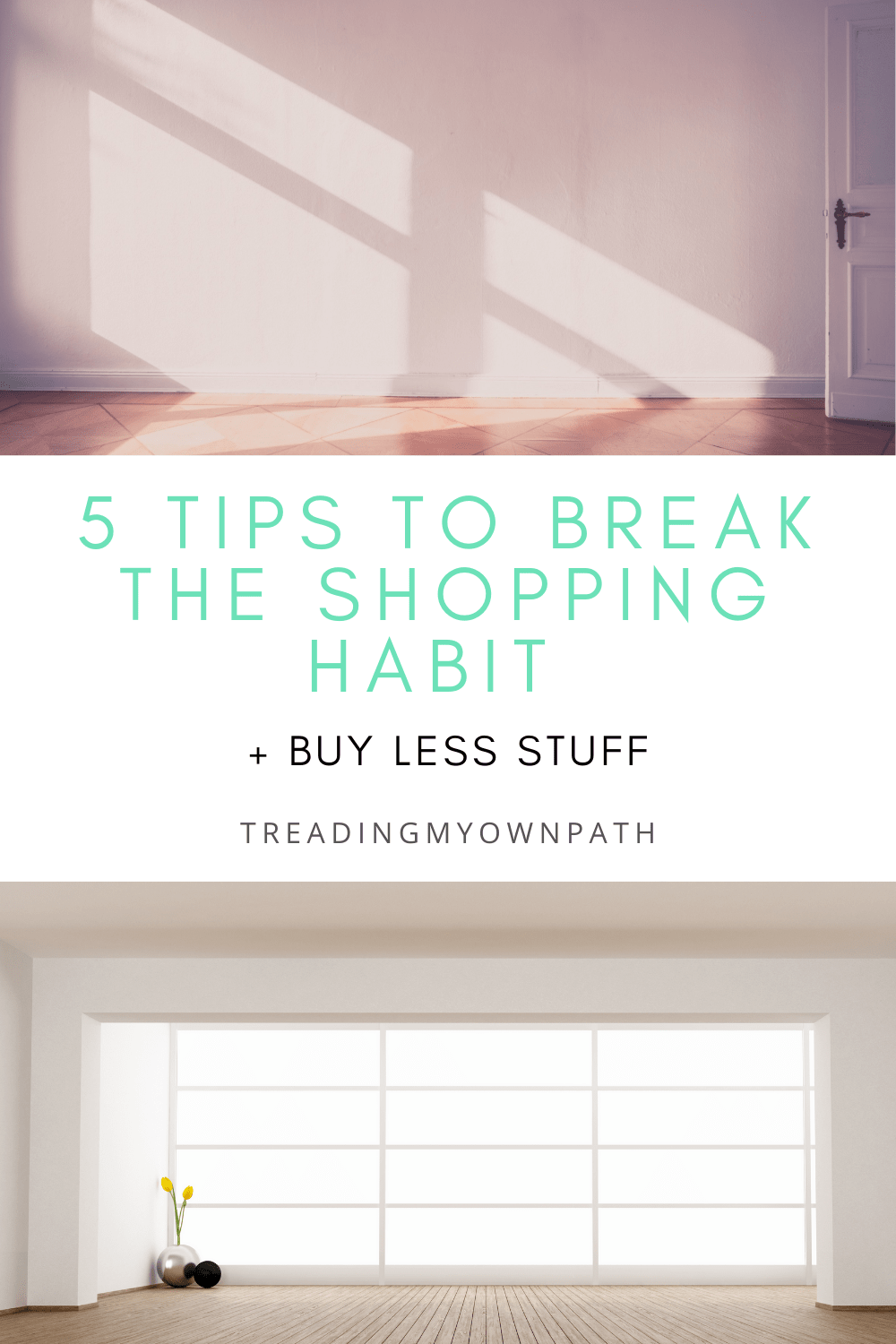
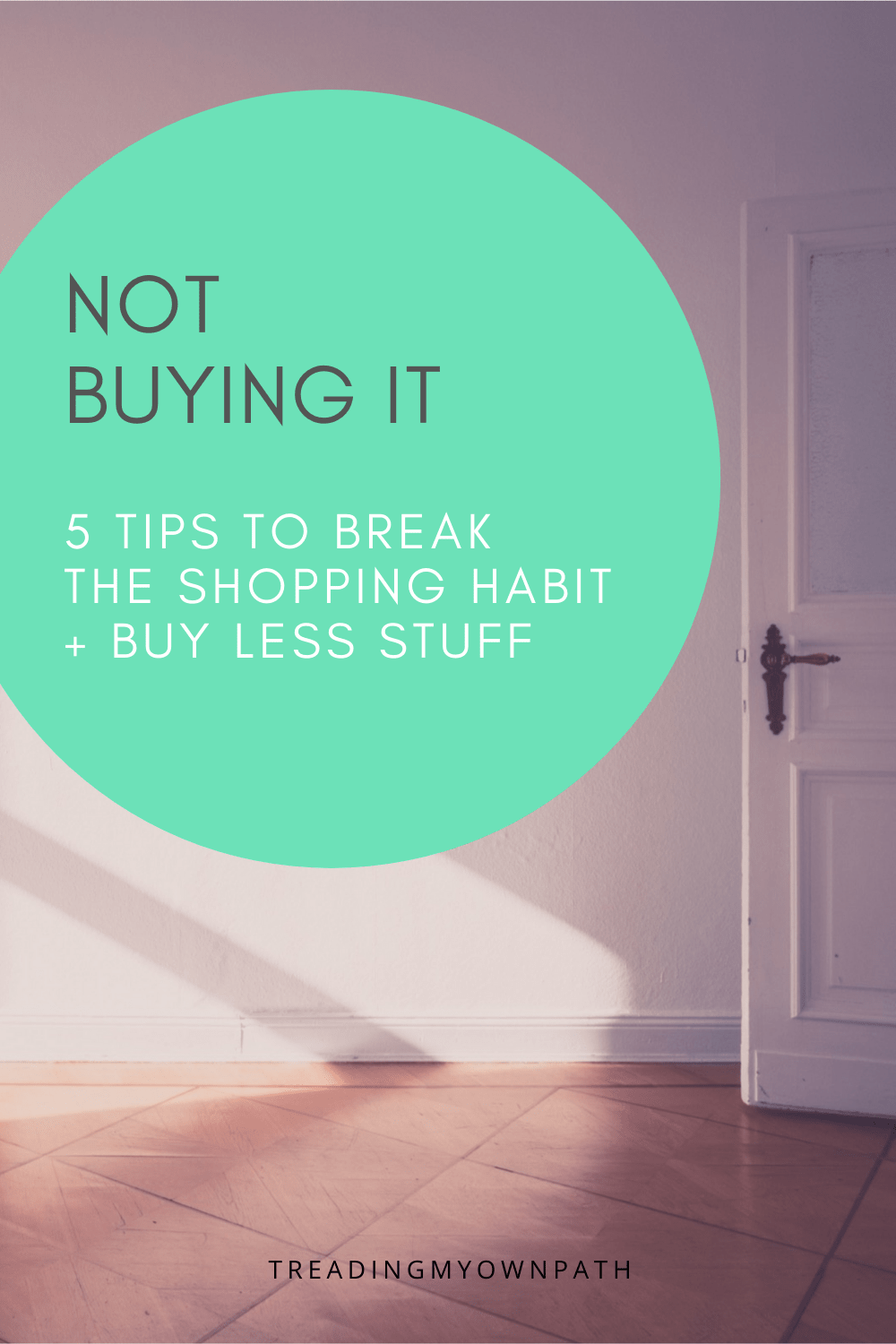


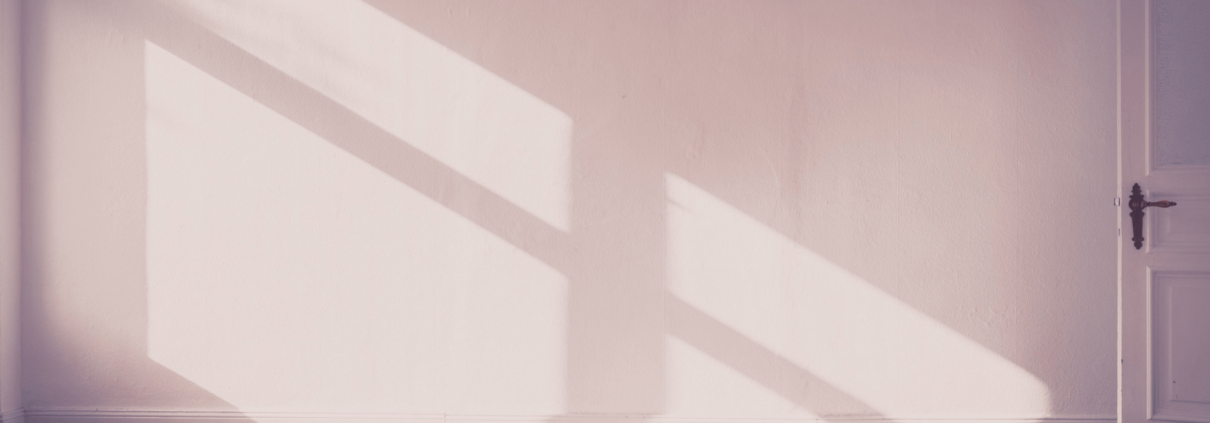



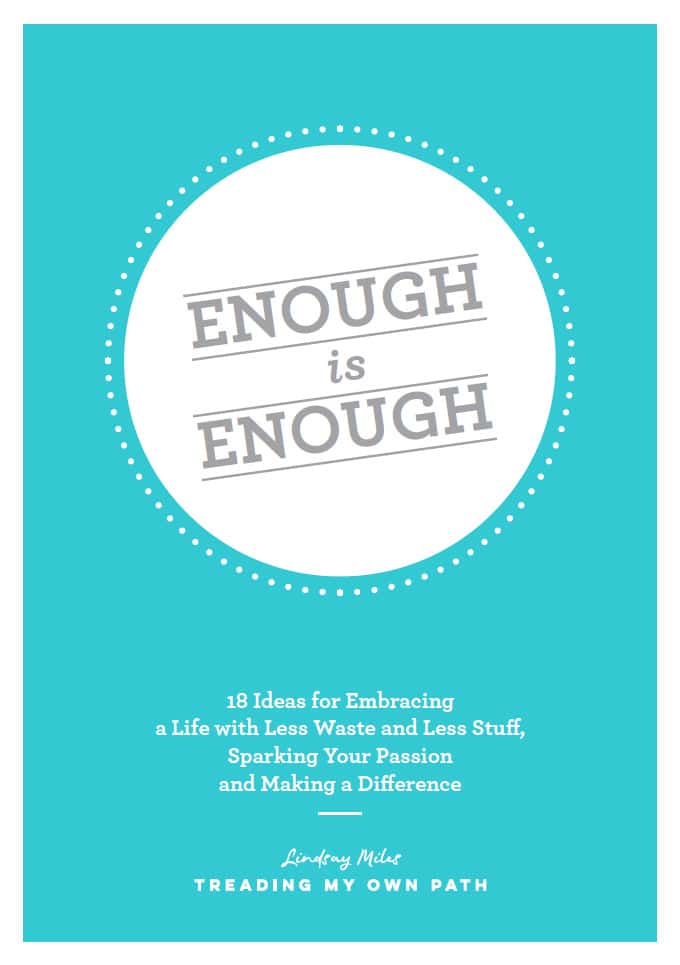
Really interesting and educational
Thanks Liah :)
Always inspired by your blog posts. Thank you so much and am really enjoying your book too. I deeply admire your generosity and integrity.
Thank you so much Pam, and I’m honoured that you’re reading my book! I hope you find it useful and practical.
I took slow steps to stop buying clothes.
First, I ruthlessly got rid of (almost) anything I hadn’t worn in the past 12 months.
I then started only buying non-synthetic clothing (which is really hard), and preferably fair trade.
Then last year, I set myself the challenge of simply not buying clothes for 12 months.
I’m not perfect, and still buy stuff – mostly books, but I’ve now come to realise how many clothes I actually have, plus no-one actually notices if you wear something a couple of times in a week, so have only made 1 purchase this year.
I had a pretty similar journey when it came to reducing my wardrobe, Clare! I’ve now found a charity shop locally that sells a lot of natural fibres (it sells a lot of premium brands, which helps). And I agree, you realise how much you own that you don’t wear. And yes, no-one notices if you repeat your outfits!
strategies on breaking the consumption habit are so needed—this is great.
for me personally, challenging myself to a “buy nothing new” year was transformative. i only made exceptions for obvious things (food, etc) and socks and underwear. i have never gone back to buying new items routinely because i am so satisfied with what i have found second-hand. in many—probably MOST—cases, the used items have been of better quality than i could have afforded to purchase new. and because i have to look a little harder for needed items, it removes the impulse buying to some degree. i have lost the habit of shopping recreationally; i don’t even like to go into most shops now; they are overwhelming and annoying, and frankly, rather depressing places as i see nothing but fast fashion and housewares with all the negatives they imply. i am so happy avoiding buying new, and confident that what i truly need will always be out there, somewhere.
it’s all win!
I love this and I think I went on a similar journey – although I’ve never actually committed to a ‘buy nothing new’ year, or even month, I value second-hand and preloved items so much that this is always my first priority… and same as you, the desire just kind of fizzled out. Now I find it hard to believe that old me would ever go to the shops for fun or to pass the time!
These are great tips – I think one of the hardest things to do once I started my eco journey was to stop buying things. I was always pressured to do so, but I’ve learned that you don’t need all of that stuff!
Jenna ♥
Stay in touch? Life of an Earth Muffin
Thank you! And I agree (and I’ve written about this before). The hardest thing really is to stop buying stuff!
Another great article, thanks Lindsay.
My biggest weakness in the past was buying books. I now borrow virtually all the books I want to read from the library.
Thanks Darren. It’s interesting you say this, because I have actually changed my mind slightly on the books front. In the past I stopped buying books completely, but since I started writing books and appreciating the effort and the process, I have decided that sometimes if I want to support the author, that I will buy the books. I’d say I still borrow 95% of what I read, but I now allow myself a small space to buy books. It’s usually books that I’d want to refer back to – so reference books, not fiction. It’s working out okay for me so far!
Great post, I agree with everything you wrote! My biggest weakness and it just crept up on me was buying skincare (odd I know!), I found a couple of good sites and I could refine my search to vegan and cruelty free, I suddenly realised my bathroom cupboard was overflowing. I have now banned myself from buying any skincare until I use up everything I already have.
Oh Jenny it’s so interesting where these things creep up on us! I’ve had something similar with deodorant, randomly. My husband has sensitive skin and can’t use any bicarb deodorants, and whilst the clay bicarb-free recipe i have on my blog works for him he would rather buy something. But the only one he can find that doesn’t cause a reaction is in glass, and all the glass roll-on tubes everywhere drive me mad! (I save the empties up, and then give them away, as they are refillable) Anyway I keep buying sensitive skin bicarb-free options for him to try, and none of them work! (As in, they still cause a reaction.) And then I am left with overflowing drawers of deodorant to use up…
One of the problems I have is buying gifts for children at birthday parties. Usually they are things kids don’t need or even play with. More lego! More balls! More books! Even when you ask the mums what their kids want or need the answer is usually ‘I don’t know’ or ‘anything!’
About the only reasonably priced experience gift suitable for kids of a certain age is the movies. But I feel like that weirdo mum that always buys them that and realise it’s not received with as much excitement as a $20 remote control car from Kmart… that will break after 3 plays.
Feel a bit stuck with this one, and I think lot of parents are in the same boat. None of us want more plastic junk in our houses polluting the world but were struggling to find a way out. It’s simply easier to buy crap from target and the problem is that it is affordable to buy these cheap, short lived thrills for our kids.
Buying sustainable gifts it expensive. I’m happy to buy quality bamboo tshirts for my nieces but probably not for all the kids in the class. Also don’t think a home made box of rocky road will be appreciated by most parents!
Anyone have any suggestions?
I hear you Liz, I too struggle with this. One year for my daughter’s birthday I asked some relatives to buy her experiences and she got tickets to various places (most were under $20).
If you’re in Perth I could give you a specific list of some places to consider but generally you could try water parks, play centres, trampoline centres, wildlife parks, indoor rock climbing, zoos, aquariums and science places. Possibly also tickets to a play, or kids workshops that sometimes run during school holidays.
Here’s an idea to make your gift more appreciated. Find a good video on YouTube or a website of the place you have purchased the ticket for. For example “Perth Zoo highlights”. The create a QR code for the website, print it and stick it inside the card
When the child sees the code they will scan it and they can watch a video of the place they will visit. That should hopefully get them excited about their gift. You could write on the envelope something like “inside is your ticket to a mystery experience “ and decorate it.
I hope this helps. I think we need to be creative when trying to change the expectations around gifts. I will be doing this for a birthday party my daughter is attending this weekend so hopefully her experience is appreciated.
This is so good Jo, thanks so much for sharing! I love the QR code tip, what a brilliant idea.
Love the QR code tip, thanks Jo. Will have a think about other experiences that might be affordable …and was thinking I could try to do a joint gift with another family for the more expensive ones
Really interesting thoughts, Liz. Not having kids myself it’s hard for me to make suggestions, but I guess I’d try to relish being the weirdo mum ;) In a few weeks the kids won’t remember any presents they got at their party!
I think second-hand can be an option, depending on what it is. There are plenty of second-hand toys in excellent condition, and at least you’re not contributing to the new stuff. But I know for many it’s a mindset thing. I gave my nephew a shirt of his favourite football team that I got from the Buy Nothing group second-hand, he didn’t notice or care that there were no ‘new’ tags.
But I agree with the sentiment about sustainable gifts. If they are not going to be used or appreciated, it’s a waste of your money.
On the subject of homemade rocky road, I once made my nephew (same one) a box of homemade cookies and he thought it was the best gift in the whole world! So you might be surprised!
No idea if that helps, but those are my thoughts!
Thanks Lindsay.
I guess it’s just the time needed that comes with searching for a second hand item that is in good enough condition for a gift. We have lots of small shops near us but their offerings are pretty small and I have to drive for 30 mins to get to one of bigger shops.
But now I think of it, it’s perhaps worth me making one trip and buying a heap of gifts that I know I can use for future gifts.
Thanks for your support.
Liz
Ps) for sure the kids would love the rocky road but parents might not thank me for giving them more sugar after a party
Yes that’s true Liz, perhaps making a trip and buying a small collection of useful items for future gifts. I’m pretty sure my mum did this when I was a kid (not the second-hand stuff, but the small stockpile!) Worst case they never get used and you simply donate them back to the charity shop.
Haha, well that’s on the parents for not providing a healthy well-balanced spread for the party then! ;)
We held “no gift” parties and asked our kids to pick one thing they cared the most about to make as their “Giving gift”. To help our kids decide we had them choose from animals, people, or earth and then narrow it down from there. We asked friends to donate to it.
I would suggest asking the parent what is the one thing they care about most and then offer to donate to it. Example…“Jimmy loves polar bears… “ So you donate to to a place that helps polar bears and Jimmy gets a special picture knowing he helped saved a polar bears home…
Thats a nice idea JJ. Or we could at least offer that as an option at all future parties we hold. Especially as the kids get older and only want big electrical gadgets or computer games!
Awesome post, keep up the awesome work!!!
Thanks Daniel!
My issue is not what I buy, it’s what my husband and teens bring in!!! So when I try to clean and downsize I am accused of getting rid of “everything”.
Navigating other people’s stuff is such a minefield, JJ!
I switched my buying stuff “fix” with fixing stuff I already have that is broken.
No buying doesn’t mean no spending! I just spent over $150 getting 2 chairs fixed. They’re from the 1930s and get used everyday. I agree, its much more satisfyingly than buying new stuff. I had to track down a repair person (there were more than I thought).
This is true and a good point Ali. Even when we have the tools and materials to mend things already in our homes, it’s likely that we have to pay for them somewhere along the line. But as you say, there is something deeply satisfying about fixing stuff and keeping it in use.
I’m with you on this JJ, it is immensely satisfying to fix things! (Even if it is someone else who actually does the fixing.)
I endorse the “no gift” parties. And don’t ask for a donation/experience either as then you can’t even regift an unopneed toy. I was thrilled last year when my son got an invitation saying” we are tying to reduce our consumption as a family. Please no gifts”. and didn’t ask for alternatives. Because the endless parties get expensive as well.. Another party asked for a can of cat-food for the SPCA instead of a gift because the child loved cats.
I LOVE the cat food gift idea, Ali, that’s so great! I’m also a fan of the ‘no gifts, and don’t suggest alternatives’ approach, but it can depend on the audience. Some people are so hard-wired to buy things or bring gifts that they can’t understand the idea of ‘nothing’, and they feel really bad about the whole approach, in which case experiences – or cat food tins! – can be good suggestions. The whole git-giving is a minefield to navigate!
For my mum’s 70th we asked people to bring either a box of food for foodbank or a handbag full of toiletries for homeless women (as part of the In The Bag campaign). We chose these specifically so that people would have something to bring. We included specific information from the websites with the invite so people would know exactly what could and couldn’t be donated.
She received at least 2 shopping trolleys full of food and about 20 handbags and she got the pleasure of dropping these donations off.
People love to buy things for other people, and Ive been to several “no gift” parties and still seen tables piled with gifts. Ironically, my mother is one of those people who still wants to bring a gift to a “no gift” party! Its not fair to take away the pleasure that gift giving gives to other people but at least this way I think everyone was satisfied.
I had my income cut to zero for 9 months over 1st lockdown because I was living off benefits which got cut and took 9 whole months and a lawyer to reinstate. Excruciating at first, when I found out I could survive anyway it was extremely liberating. There’s always another way than shopping to solve the problem, and it freed my creative side so, so much. Barbaric, but it improved my life beyond measure. Now I could spend but don’t want to. I found someone on olio to make me clothes locally too and with Gumtree I never need to go to shops. Only supermarkets for meat and dairy. Veg and random food from Olio. It’s a great app.
I’m so sorry to hear that Barbara, it must have been super stressful and unsettling at the time – although of course it is great to hear that you’ve been able to survive (and it sounds like thrive, too!) Olio is a great app, it’s only just taking off here (despite my efforts to promote it every time I can) but I do follow along on their social media and it is amazing what gets shared.
Thanks for sharing your experience with us.
Great encouragement! Thank you! What broke the camel’s back for me was sorting through my late grandparents’ estate. They were up to their eyeballs in debt yet drowning in junk and it was very sobering and draining to deal with the hoard left behind. It really made me look at my choices and change my attachment to things. The other factor was relatives fighting over some of the “crap”. To them it was me “wanting” it all and first dibs when in reality, living there and trying to sort through it felt akin to drowning. It was hard to throw things away and see dumpsters heading to a landfill. The lesson being don’t buy trash. What is trash? Some days are better than others, especially living in a developing country like here, south africa. But really small actions daily make a big difference! How do people still use plastic shopping bags…? Thank you everyone, we can change!
I enjoy reading your blogs Lindsay. Thank you.
The fact of the matter is that “yes”, we DO have a global over consumption issue. Mind you, it is great to see that as we progress forward with the learned knowledge and acquired education of such issues, that there are entities throughout the planet working on solutions to help combat such large scale “throw away to buy new” mentality. There are entrepreneurs/businesses in the technology sector who are building Apps/platforms as we speak to reshape the Sharing Economy into a scale that of something we have not yet experienced…and for the better of the planet. I have personally been keeping an eye on these in progress with anticipation. One that stands out above others in this field to date call themselves ShareRing Global. They are encouraging people to use their upcoming online platform to share or give away their unwanted goods (instead of throwing them away) amongst a great variety of other services they have available within their arsenal of products (many also to do with keeping “contactless” during this covid pandemic) on their upcoming App, which will launch in July 2021. If you are interested in seeing what they are doing, the best way to find them is either google them, otherwise they have a great “Twitter” presence ( @ShareRingGlobal ). Their platform is aiming to be the “Amazon” of the Sharing Economy of the future.
I look forward to your next blog :)